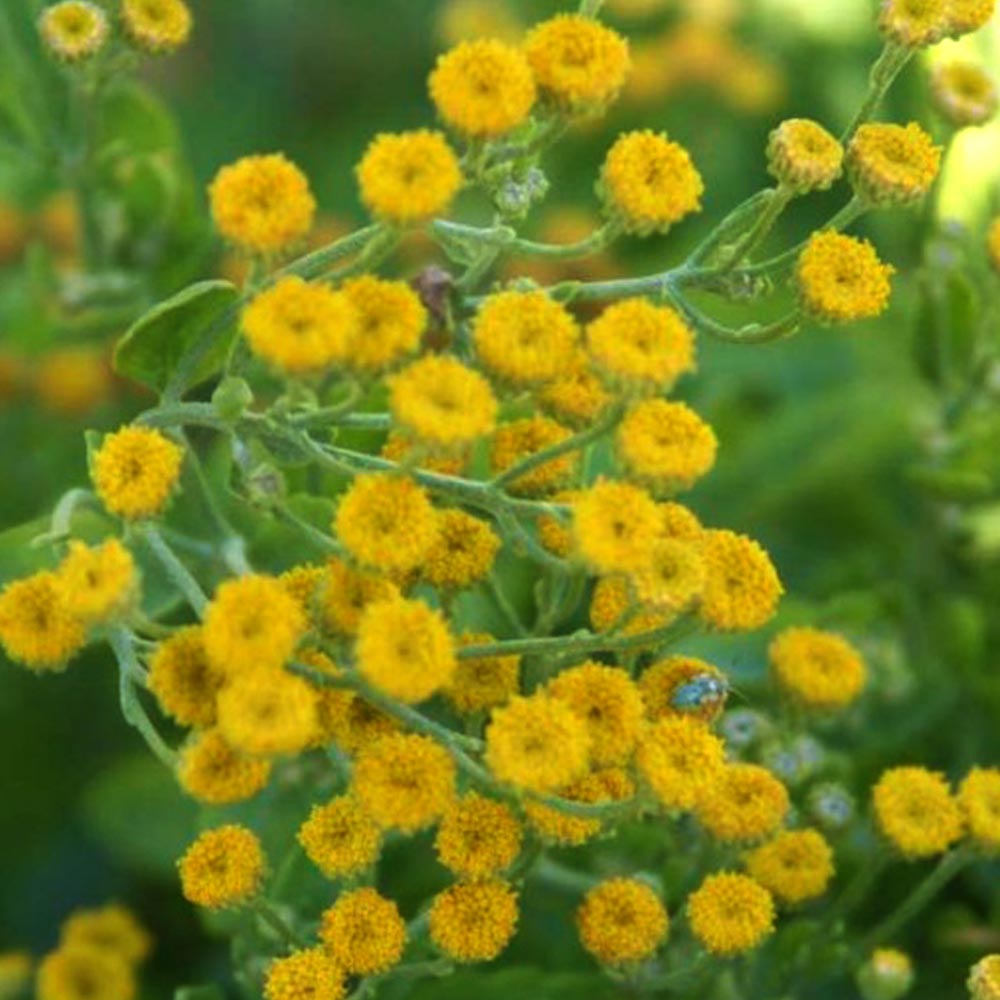No products in the cart.
Tanacetum balsamita
A perennial known for its distinctively aromatic foliage and tiny yellow flowers
Rated 0 out of 5
0 customer reviews
3,90 €
Only 21 item(s) left in stock!
Tags: aromatique, couleur, fleurs, graphique, perennial, potted plant, soleil, vivace, vivace en pot
SKU: pda383
Category: Balcony-Friendly, Bees and Butterflies, Bouquet, Culinary, Distillations, DyeItYourself, Fragrant, Frost Hardy, Ground Cover, Medicinal, Rewild

Tanacetum balsamita
3,90 €
Only 21 item(s) left in stock!
Tanacetum balsamita is known for its powerfully spearmint-scented foliage and delicate yellow flowers.
The leaves are dark green, extremely fragrant, oval and serrated.
-
- They have a strong, sweet, spearmint scent and slightly bitter taste. It reminds many of the taste of commercial chewing gum or a combination of mint and camphor.
- They were traditionally used to flavor beverages and foods, and it has a long-standing association with various cultural practices.
- They can also be used as a natural air freshener
The flowers appear in small, button-shaped clusters of bright yellow, throughout the summer months.
Historically, Tanacetum balsamita has been prized for its aromatic properties, its use in herbal medicine, cooking, and even as a natural air freshener.
👨🌾 GARDENING TIPS 👨🌾: Tanacetum balsamita
-
- The best time to collect fresh leaves for infusions or other culinary uses is between March and October
- The best time to collect leaves for drying is in July (just before the plant begins to flower)
- The fragrance is strongest in the morning – so collecting the leaves in the morning will allow you to extract more for less
- Human consumption of common tansy has been practiced for centuries with few ill effects, yet the toxic properties of the plants are cumulative and long term consumption of large quantities has caused convulsions and even death.
-
- So please don’t eat too much of it.
-
- Most species thrive in full sun and well-drained soil; some tolerate partial shade.
- Regular pruning of spent flowers encourages bushy growth and prevents excessive self-seeding.
- Companion planting potential: repels pests in vegetable gardens (e.g., aphids, ants) and attracts beneficial insects.
- Because of their rhizomatous habit, containment may be necessary to prevent aggressive spreading.
👩🍳 COOKING AND DYING TIPS 👩🍳
While edible uses are limited due to thujone and other bitter compounds, several species of Tanacetum have historical applications in:
-
-
Culinary flavoring of bitters, liqueurs, or herbal teas (in very small amounts).
- Tanacetum balsamita– Leaves have a strong, aromatic scent reminiscent of mint.
- Tanacetum vulgare – add to liqueurs but sparingly
-
Folk medicine for digestive, menstrual, and parasitic ailments.
- Tanacetum parthenium – used historically for cramps/migraine prevention because the leaves contain parthenolide
-
Dyeing: yellow and green tones can be obtained from leaves and flowers, sometimes enhanced with mordants like alum or iron salts.
- Tanacetum vulgare – produces a strong yellow to greenish-yellow dye
-
Learn more about dying with Tansy:
The Tales & The Botany : Tanacetum balsamita
The principal phytochemical contained in the leaves is carvone – the same that we can find in caraway seeds, fennel and dill.
It is said that :
-
- Tanacetum balsamita was used as a bookmark in the Middle Ages specifically for the Bible to keep pages free from various moths.
- If you rub a fresh leaf on a bee sting or horse fly bite, your pain will be relieved. To be tested …
In the sixteenth century it was considered to be “necessary for a garden” in England – a list compiled in or around 1525 by Thomas Fromond, a Surry landowner.
The plants were classified by species having a specific purpose or by species destined for a ‘sophisticated pleasure garden’.
It was grown in the garden of Charlemagne the Great in the eighth century and in the herb gardens of Swiss Benedictine monks as a treatment for intestinal worms, rheumatism, fevers and digestive problems.
As it is also known for its pest-repellent properties, Tansy can help protect your garden from certain pests including:
-
-
Aphids – Tansy’s strong aroma is a natural deterrent for aphids, which are commonly found on plants like roses, vegetables, and fruit trees.
-
Japanese Beetles/Ants/Caterpillars – especially those that are commonly found on plants or vegetables
-
Flies – Tansy has been historically used to keep flies at bay, especially in areas where food is stored or on animal pastures.
-
Moths – Known as the “moth plant,” Tansy’s leaves have been used to repel moths and protect stored goods like wool and fabrics
-
According to liquor historian A. J. Baime, in the 19th century Tennessee whiskey magnate Jack Daniel enjoyed drinking his own whiskey with sugar and crushed tansy leaf – I’ll confirm, it is quite tasty!
The flowers make a bright yellow dye for those who are keen home dyers 🙂
🌸 Floral Morphology
The flowers of Tanacetum species are typically small, tightly clustered, and range in color from bright yellow to pale cream or white.
They are usually daisy-like or button-shaped, forming flat-topped inflorescences that attract pollinators such as bees, butterflies, and flies.
Fruits are usually small achenes that are easily dispersed by wind.
Leaves are often pinnately divided, fern-like, and aromatic when crushed. Their fine texture contrasts beautifully with the dense flower clusters.
Stems can be erect or spreading, depending on the species, and many Tanacetum plants spread via rhizomes, forming clumps or colonies in suitable habitats.
🌱 Reproductive Biology
Tanacetum species reproduce sexually via seeds and vegetatively via rhizomes. Flowers are usually insect-pollinated, supporting local pollinator populations.
Seed germination varies by species but generally occurs in spring, while rhizomatous growth allows rapid colonization of suitable habitats.
Most species are perennial and hardy in temperate climates, tolerating moderate drought once established.
From a botanical standpoint, the Tanacetum genus offers an intriguing mix of ornamental beauty, chemical utility, and historical significance.
Its diverse species connect horticulture, ethnobotany, and natural dyeing traditions, demonstrating the genus’s long-standing relationship with humans.
Other Names:
Costmary
Alecost
Balsam herb
Bible leaf
Mint geranium
Origine:
Mediterranean
| Weight | 0,5 kg |
|---|---|
| Flower Color | 🟡 Yellow |
| Flowering | August, September, October |
| Exposure | Full Sun |
| Frost Tolerance | -10°C to -15°C |
| Size | 1m H x 0.6m W |
| Planting Season | March to May, September to November |
Reviews
0
Rated 0 out of 5
0 customer reviews
5
0
4
0
3
0
2
0
1
0
Only logged in customers who have purchased this product may leave a review.
Related Products
Mentha x piperita ‘Chartreuse’
A spicy mint, known for its use in the production of liqueurs and herbal teas.
A spicy mint, known for its use in the production of liqueurs and herbal teas.
Rated 0 out of 5
Cerastium tomentosum var. columnae
A grey-green spreading ground cover from the mountains.
A grey-green spreading ground cover from the mountains.
Rated 0 out of 5
Melissa officinalis
A perennial plant in the mint family that is adored by bees, royal families and tea drinkers.
A perennial plant in the mint family that is adored by bees, royal families and tea drinkers.
Rated 0 out of 5
Stachys byzantina
Silky white-grey leaves and tall striking flowers
Silky white-grey leaves and tall striking flowers
Rated 0 out of 5
Hieracium maculatum Leopard
A native perennial with blue-green leaves and a tall yellow flower
A native perennial with blue-green leaves and a tall yellow flower
Rated 0 out of 5
Kalanchoe daigremontiana
A toothy succulent from Madagascar, known as the Mother of Thousands.
A toothy succulent from Madagascar, known as the Mother of Thousands.
Rated 0 out of 5
Tanacetum densum subsp amani
A shrublet composed of soft, finely divided silvery gray-white leaves.
A shrublet composed of soft, finely divided silvery gray-white leaves.
Rated 0 out of 5
Erigeron kavinskianus
A daisy-like carpet of flowers
A daisy-like carpet of flowers
Rated 0 out of 5
Delosperma cooperi
A dwarf perennial known for its vermillion colored flowers
A dwarf perennial known for its vermillion colored flowers
Rated 0 out of 5
Artemisia Valerie Finnis
A semi-evergreen, aromatic variation on the theme of Artemisia.
A semi-evergreen, aromatic variation on the theme of Artemisia.
Rated 0 out of 5
Glechoma hederacea
A sweet smelling ground cover, producing little blue flowers all summer long.
A sweet smelling ground cover, producing little blue flowers all summer long.
Rated 0 out of 5
Trachelospermum asiaticum ‘Ogon Nishiki’
Jasmine with colorful foliage and lovely white flowers in summer
Jasmine with colorful foliage and lovely white flowers in summer
Rated 0 out of 5
Tradescantia Blushing Bride
Gorgeous blushes of pink and white that appear in the coldest nights.
Gorgeous blushes of pink and white that appear in the coldest nights.
Rated 0 out of 5
Hellebore argutifolius
Winter flowering perennial with marbled blue-green leaves
Winter flowering perennial with marbled blue-green leaves
Rated 0 out of 5
Echinacea purpurea
A perennial with purple flowers all summer long
A perennial with purple flowers all summer long
Rated 0 out of 5
Vinca minor
Looping elegance and ability to form a low flowering ground cover
Looping elegance and ability to form a low flowering ground cover
Rated 0 out of 5
Euphorbia cyparissias Clarice Howard
A Euphorbia that resembles a soft little cyprus tree
A Euphorbia that resembles a soft little cyprus tree
Rated 0 out of 5
Euphorbia myrsinites
Known for its draping form of silver-gray foliage and radiant blooms.
Known for its draping form of silver-gray foliage and radiant blooms.
Rated 0 out of 5
recent view product
Koeleria glauca Blue Sprite
An ornamental, low growing blue grass
An ornamental, low growing blue grass
Rated 0 out of 5
Achillea sibirica Love Parade
A unique variety with large pink flowers and shiny foliage
A unique variety with large pink flowers and shiny foliage
Rated 0 out of 5
Salvia officinalis
A fragrant herb used in many cultures for cooking and deserts.
A fragrant herb used in many cultures for cooking and deserts.
Rated 0 out of 5
Monarda didyma
A perennial with unusual fire colored flowers and fragrant foliage
A perennial with unusual fire colored flowers and fragrant foliage
Rated 0 out of 5
Rosmarinus officinalis
A drought tolerant, aromatic, perennial that is the center of Mediterranean cuisin
A drought tolerant, aromatic, perennial that is the center of Mediterranean cuisin
Rated 0 out of 5
















































There are no reviews yet.